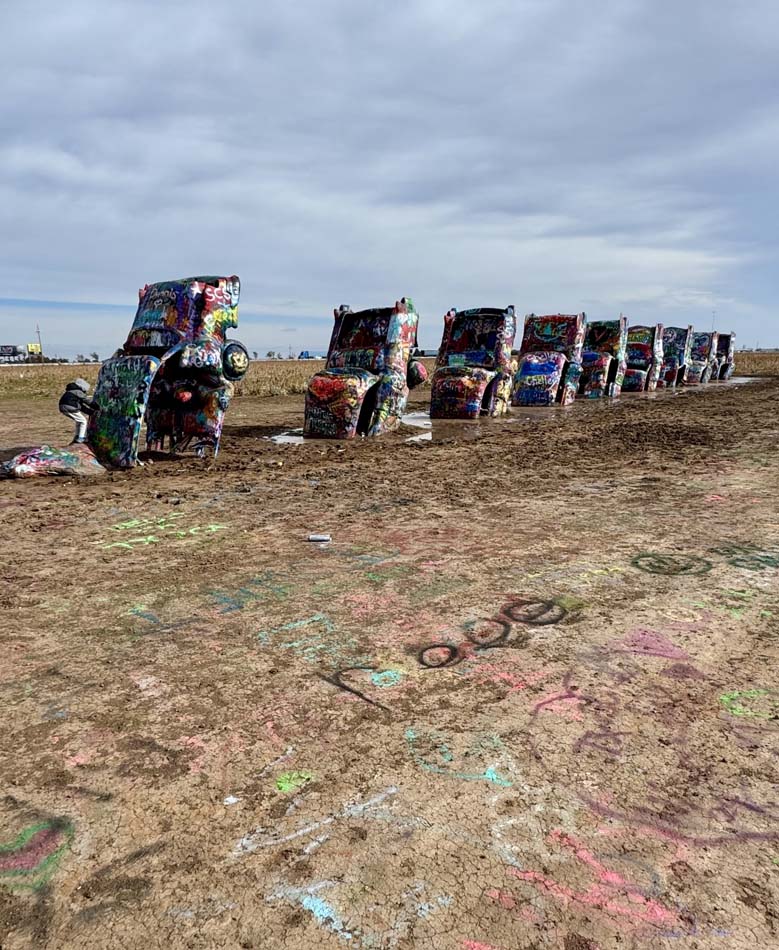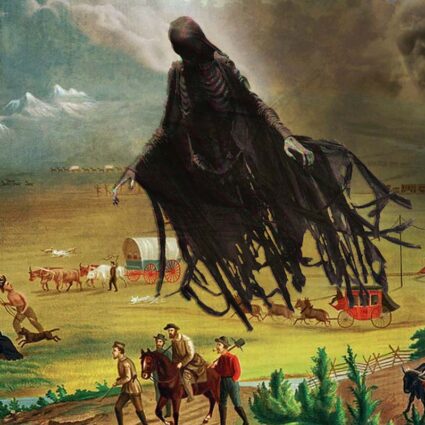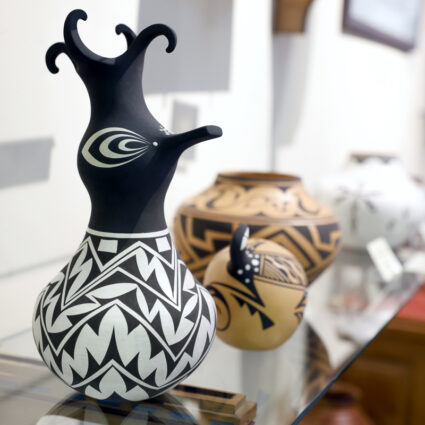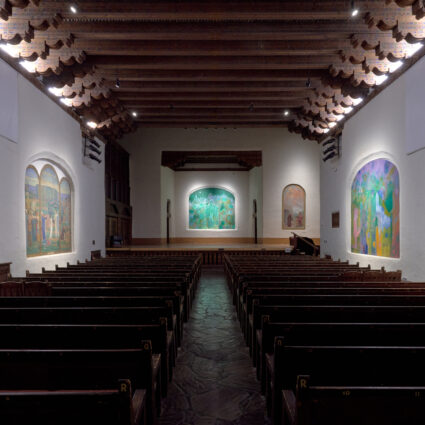Hallie Ayres follows the barbed wire strand to contrast the hypervisibility of Cadillac Ranch, the secrecy of Pantex, and the site-specificity of Combine City.

This article is part of our The Hyperlocal series, a continuation of the ideas explored in Southwest Contemporary Vol. 11.
In late 1982, peace activist Jim Douglas spotted an armored white train snaking into the Trident Naval Submarine Base in Bangor, Washington. Rumored to be carrying nuclear warheads, the train’s sighting activated a network of anti-nuclear activists across the nation who, over the next few years, meticulously tracked the whereabouts of these enigmatic engined beasts. Each of these trains was estimated to carry up to 200 hydrogen bombs, and they all originated in the Pantex Plant in Amarillo, Texas, a city that consequently dons the moniker “Bomb City.”
Pantex has historically embraced the obscurity that Amarillo’s desert locale affords it. In contrast, Amarillo is also home to a hypervisible range of arts commissions around the city, playing into the idea of the desert as a tabula rasa ripe for such eccentricities. Curiously, the history of barbed wire has impacted both of these divergent impulses toward visibility around land use. In Amarillo, which in large part owes its founding to barbed wire, this fencing technology maintains the capacity to either accentuate or conceal that which it surrounds.
Originally the final assembly facility for the U.S.’s nuclear weapons, Pantex is currently the country’s only nuclear weapons disassembly facility and plutonium storage site. Pantex exists on 16,000 acres that the Department of the Army condemned and seized from German immigrant farmers in 1942 in order to construct a WWII munitions plant. Nineteen families were given two weeks to get off the land and, in exchange, received $100 for relocation expenses. After the war ended, the land was deeded to Texas Tech University as an experimental agriculture station, but the government reclaimed it in 1950. Within a year, the plant was converted into a nuclear weapons assembly site operated by the Atomic Energy Commission.
In Amarillo, barbed wire either accentuates or conceals that which it surrounds.
Today it is estimated that Pantex stores anywhere between 17,000 and 20,000 plutonium pits, the spheres of plutonium that trigger a nuclear explosion. Up to 13,000 of these are calculated as surplus to military needs. Pantex is also currently the only nuclear plant in the U.S. nuclear weapons production complex where an inadvertent nuclear explosion could occur, though the talking heads assure that this possibility is very remote.
Throughout the Cold War, in addition to the unmarked white trains, inconspicuous box trucks moved in and out of Pantex around twice daily, according to observations by nuke-watch activists. These activists, publishing in the magazine Sojourners, estimated that assembled warheads covertly traversed 4.5 million miles of public highway per year, leaving Pantex for weapons depots nationwide.
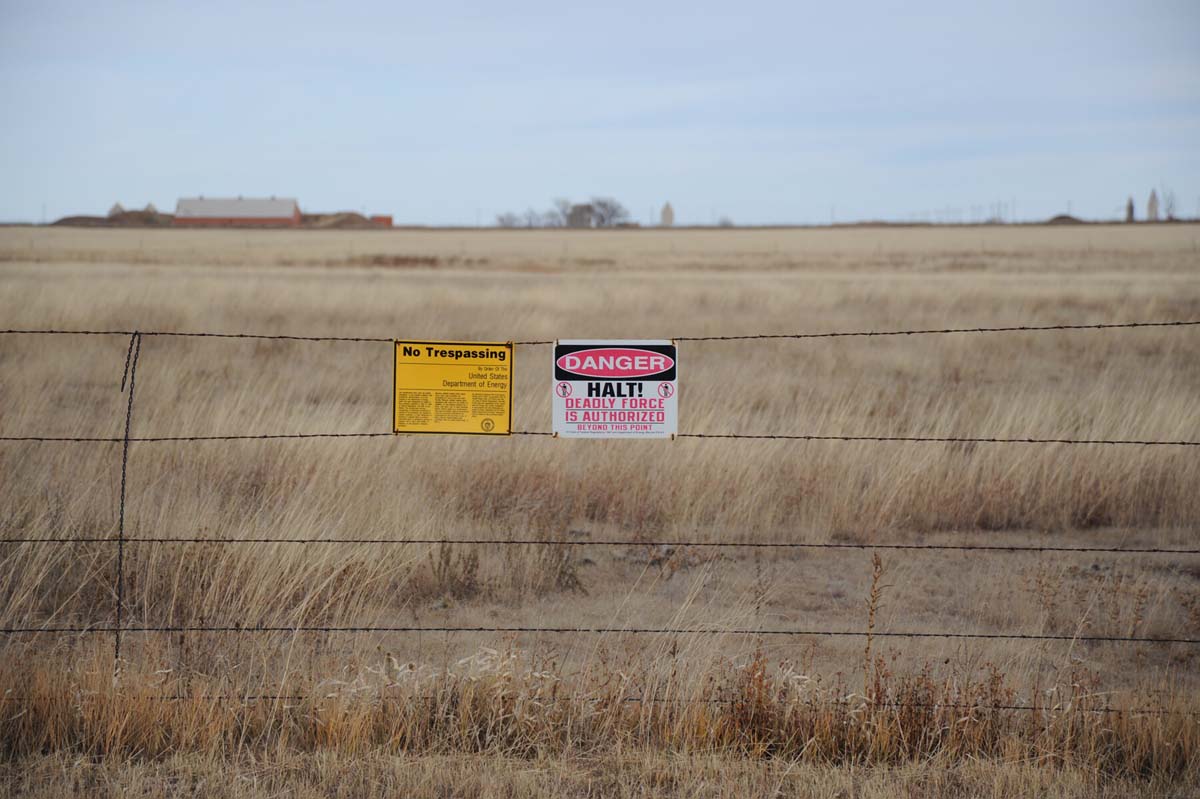
In one of the few book-length studies on Pantex, author A.G. Mojtabai notes the “long invisibility of the Pantex plant itself,” at times even more strikingly inconspicuous than the white trains transporting its dirty work, trains that had remained unidentified for over twenty years prior to Jim Douglas’s first sighting. Published in 1986, Mojtabai’s book, Blessed Assurance: At Home With the Bomb in Amarillo, Texas, at one point describes a poster she sees in an Amarillo office that depicts, in the pleasant company of “the glories of Amarillo,” a “fence [that] surrounds a sunny blank space and the words ‘Pantex Plant.’ […] There is not the faintest feathering of the surface to suggest vegetation—not a stem, not a speck, of detail. The wire fence encloses nothing at all.”
Naturally, the U.S. government has a vested interest in the secrecy of its nuclear weapons manufacturing operations. Yet the existence and operations of Pantex have a uniquely occluded timeline. Proctor and Gamble, the consumer goods conglomerate, was Pantex’s first operating contractor, which led locals to consider whether the facility had been converted into a detergent plant. After five years, however, Proctor and Gamble abdicated, and Mason and Hanger, an architectural engineering firm, began to manage the facility. For much of Pantex’s existence, the sign outside the facility read simply, “United States Department of Energy, Amarillo Area Office, Pantex Plant.”
In her study, Mojtabai interviews a wide range of Amarilloans about the extent of their knowledge of Pantex’s function. Many interviewees expressed a feeling of being tricked: they knew Pantex did something with nuclear energy research, but they didn’t realize it was the final assembly point for plutonium warheads. In a 2017 interview with Amarillo Globe-News, Doris Smith, a highly outspoken and critical neighbor of Pantex for decades, corroborated this sentiment, saying, “[Pantex] didn’t necessarily lie to you; they just didn’t tell you the whole truth.” Mojtabai also catalogues a general sentiment of reticence, resignation, and overwhelming disinterest in regards to the plant: “Asking pointblank ‘How do you feel about Pantex?’ of anyone and everyone I meet in the streets of Amarillo, the first response is usually one of astounding blankness. ‘It’s out there–that’s all it means to me. I really had never thought about it.’”
As Pantex was covertly shipping out nuclear weapons to arsenals across the country, a different breed of wheeler and dealer was operating in Amarillo’s environs. Businessman and scion of an oil and gas family, Stanley Marsh 3 had, by the ’70s, achieved a prominent place in Amarillo’s pantheon of eccentrics, gaining a reputation for his garish Western wear, his often unpredictable behavior, and his large-scale art commissions. These included Robert Smithson’s Amarillo Ramp (1973), completed posthumously after Smithson died in a plane crash while surveying the site; Andrew Leicester’s Floating Mesa (1980), a series of gray-white panels installed along the side of a mesa in an attempt to make it appear as though its upper portion is suspended in air; and a series of street signs bearing cryptic messages installed throughout the city by the employees of Marsh’s Dynamite Museum. In response to general criticism, Marsh is well-known as having declared, “Art is a legalized form of insanity, and I do it very well.”
In March 1974, Marsh received a postcard from Ant Farm, a San Francisco-based architecture collective, in which they proposed what would become Cadillac Ranch, a land work featuring ten models of Cadillacs from the height of the tailfin era, buried nose-first into a patch of land along what was Route 66. By June of that year, Ant Farm and Marsh celebrated the completed installation, executed under their budget of $3,000: the cars, sourced by scouring auto junkyards and used car listings, averaged $200 each. Marsh threw an opening party, serving guacamole and gin and tonics under white tents erected in the dusty desert, while the daughter of Amarillo’s Cadillac dealer placed plastic bouquets next to each car. The artists doused the ‘49 Cadillac in a bottle of champagne to declare Cadillac Ranch open, and it soon garnered national attention.
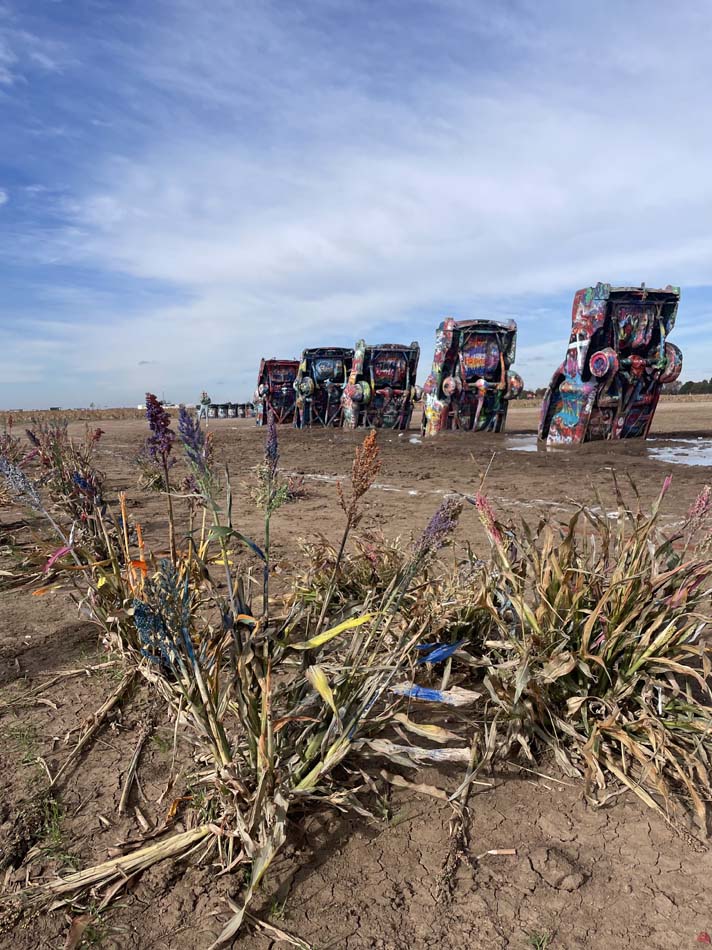
The monument serves not only as an ironic toast to American postwar consumerism but also as an ethnography of sorts, putting on display the immense cultural baggage borne by the Cadillac while chronicling the evolution of the luxury vehicle’s fins from 1949 to 1963. With tailfins notoriously styled after the Lockheed P-38 Lightning fighter aircraft, the Cadillac soared in sales during the postwar period. In 1950, when Cadillac broke the record for most sales of a luxury car line—over 100,000 units—Fortune Magazine declared, “Probably never before had one material object become so much the focus for so many of the aspirations that propel the American ego.”
“We were having fun,” Marsh recalled in an interview with Amarillo’s news station, donning the insouciant tone that accompanies outlandish wealth. He continued, “We thought it’d be fun to play with the Cadillac tailfin. And we didn’t have any deeper, serious motive; we were having fun working hard.”
In a 2004 text in Cabinet Magazine, Joseph Masco coined the term “desert modernism,” or “the dual process of mythologizing and monumentalizing through cognitive erasure.” About the contemporary American desert, he writes that it “exists as (post)modernist frontier and sacrifice zone, simultaneously a fantasy playground where individuals move to reinvent themselves, and a technoscientific wasteland where the most dangerous projects of militarized society are located.” Within this desert modernist aesthetic, one can easily contrast the secrecy of Pantex and the simultaneous larger-than-life persona of Marsh and his range of artistic assertions. Bisecting both of these entities is barbed wire, with its janus-face characteristic that enables a dialectic between the invisible and the visible.
In 1881, the inventor of barbed wire, Joseph Glidden of DeKalb, Illinois, and his business partner Henry B. Sanborn, purchased the ninety-five sections of land in the Panhandle that became the Frying Pan Ranch, at the time the largest ranching property to be enclosed by barbed wire fencing—around 150 miles of it. This ranch was meant to prove to resistant Texas cowboys that cattle could be raised within the confines of barbed wire as opposed to relying on the cattle drives of the open range.
Glidden and Sanborn amicably dissolved their partnership in 1894, and, in 1898, Glidden deeded his share of the Frying Pan to his son-in-law, William Henry Bush. Sanborn, meanwhile, had settled full-time in the Panhandle and began pursuing, perhaps monomaniacally, the development of the area immediately surrounding the ranch. In 1887, James T. Berry, a townsite developer acting on behalf of the Fort Worth and Denver Railroad, had established what he called Rag Town, essentially a tent camp for railroad engineers and construction crews, neighboring the Frying Pan. Sanborn started buying parcels of land around Rag Town, where he thought a town should be. Eventually, the playa lake at the center of Berry’s Rag Town flooded in 1889, and Sanborn managed to relocate the town’s commerce to his preferred site, solidifying the location of Amarillo.

A mere ten years later, after a bit of dubious dealing on Sanborn’s part, Amarillo had become the hub where railroad lines such as the Pecos Valley, the Santa Fe, and the Fort Worth and Denver all met, allowing the town to develop into one of the world’s leading cattle-shipping markets.
Soon after came the realization of Amarillo’s mineral-rich foundation, with natural gas discovered in 1918, and petroleum in 1921. By 1927, the Federal Bureau of Mines began mining for helium there. For nearly a decade, Amarillo was the only producer of commercial helium in the world; even by 1964, ninety-five percent of the world’s helium was produced within a 250-mile radius of Amarillo.
In short, the profit-driven desire to prove to cowboys the effectiveness of barbed wire is what initially prompted the siting of Amarillo; the railroad junctures then catalyzed its further development. Through the turn of the century, settlers and homesteaders rapidly divided the Panhandle into large, privately-owned parcels of ranchland, fenced by barbed wire.
The politics of what retains public visibility take on a sense of profound importance, especially in a region that is often said to be so flat that one can see into tomorrow.
The consequences of Amarillo’s first fifty years can accordingly be distilled into two primary phenomena that drive Amarillo through the 20th century. Naturally, these phenomena are interlinked. The first is that certain families became fabulously wealthy through the privatization of extractive economies on land that contained natural resource deposits, and the second is that this particular breed of land privatization in the Panhandle was operating on scales of vastness hitherto unknown in the U.S.
These ranches were so large that the expression of wealth accumulation by landowners was not immediately discernible. Barbed wire fences, visually porous entities that they are, maintain the illusion of either endless horizon or endless ownership–depending on one’s preferred vantage–yet they also obscure an immediately clear delineation of property holdings. Consequently, the politics of what retains public visibility take on a sense of profound importance, especially in a region that is often said to be so flat that one can see into tomorrow.
Stanley Marsh 3 was the grandson of early wildcatters on the Plains. He married Wendy Bush O’Brien, the granddaughter of the aforementioned William Henry Bush—the son-in-law of Joseph Glidden, inventor of barbed wire. The Marsh and Bush O’Brien combined coffers fuse four prominent means of wealth accumulation in the early 20th century on the Panhandle Plains: oil, gas, ranching, and barbed wire. The product of this profound wealth is a catalogue of arts commissions and an eccentric family lore that occupy outsize space in the Amarillo imaginary.
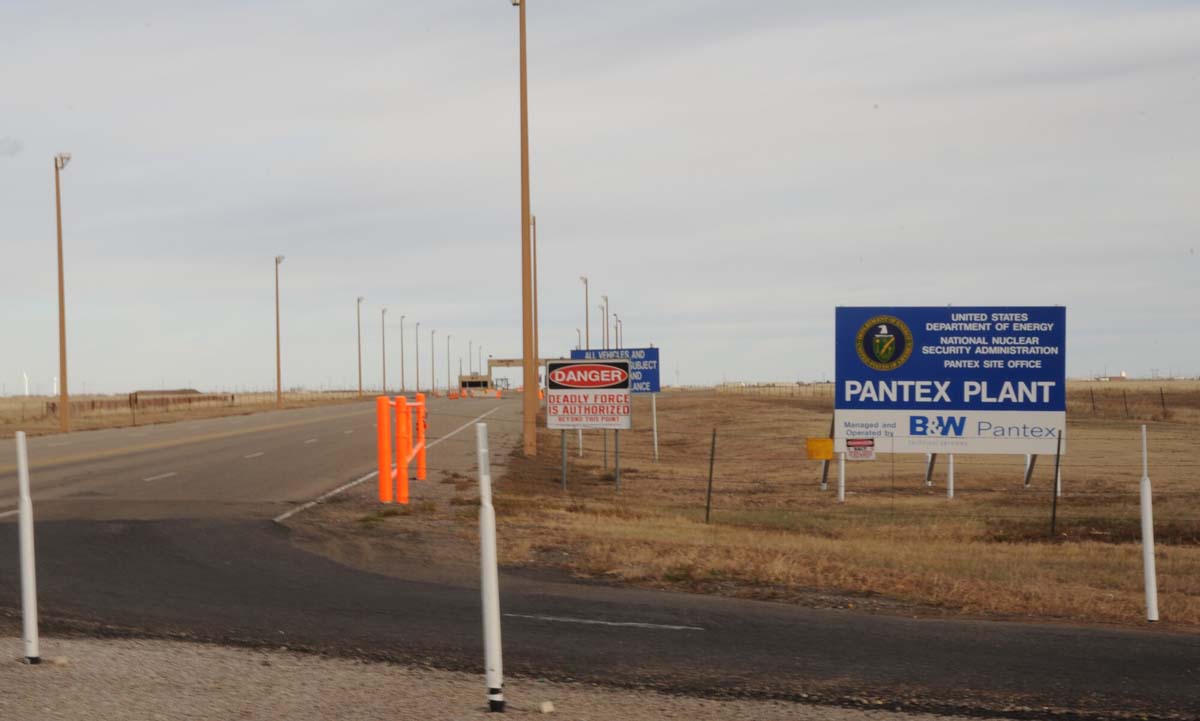
Pantex, on the other hand, retained its invisibility partly because of its enclosure by barbed wire: as is the case in prisons and detention centers, a barbed wire fence (or razor wire, these days) often renders not only invisible but also completely blank that which takes place behind. In this way, Pantex’s existence on its own forecloses a potential imaginary—hence the disinterest on the part of Mojtabai’s surveyed Amarilloans.
Marsh was vehemently opposed to Pantex’s existence in Amarillo, largely because of the way, in his view, that Pantex symbolized a certain type of federal overreach and encroachment. In the docu-comedy Plutonium Circus, made by Amarilloan George Whittenburg Ratliff in 1994, Marsh says, “One wonderful thing about Amarillo that I really like is that it’s not an unlawful town; it’s not a town where people go around being unlawful or bandits or burglars. […] It’s a lawless town. We’re a long way from anything else and it’s a town where we happen to think that the rules don’t apply to us.”
In Marsh’s mind, Pantex embodied the downfall of his utopian anarchism: law-abiding, pleated pant–wearing bureaucratic cogs operating a technoscientific wasteland that had breached Marsh’s fantasy of his desert playground. The irony, of course, is that the establishment of Pantex came about through campaigns of land dispossession analogous to those of which Marsh was descendent and beneficiary.
A counter example to these desert modernist fantasies is Combine City (2002)—an assemblage of half-buried combines in a field just southeast of Amarillo. The installation came about when farmer Orville Ladehoff was having trouble disposing of a broken-down combine. His wife jokingly suggested he just bury it. The work grew, as a tip of the hat to Cadillac Ranch, as Ladehoff outlived more of these glamorous machines—the Cadillac of farm equipment.
While inspired by Cadillac Ranch, Combine City responds to farming histories of its site, with all the buried machines having been spent toiling on the land itself prior to being put out to pasture. The difference in the capital involved in these works is reflected in the names of the installations: City and Ranch. Both works are visible and approachable from the road, though Cadillac Ranch (and its patron) is far more well-known. At Cadillac Ranch, visitors are encouraged to engage with the rusted vehicles, tagging them with spray paint. At Combine City, however, the combines maintain a tongue-in-cheek elegiac tone, with would-be graffiti artists kept at bay by a few simple strands of barbed wire.

